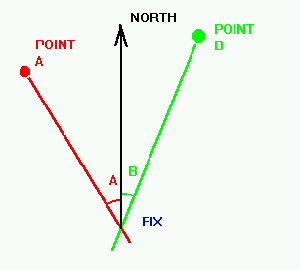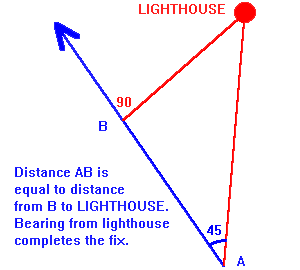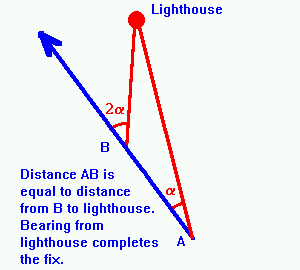Conning and Pilotage
There are several methods which can be used to determine the fix in
coastal navigation. These can also be combined with translation of
previously known position lines and /or combined with celestial
navigation position lines. Some of these methods are very accurate,
placing you on the chart to within a few metres, others are less
accurate but simpler.
The methods are:
This is the simplest and most obvious way to get a fix. Find two
objects along the coast, which are clearly indicated on the chart,
take a bearing on each, plot the bearings on the chart (don't forget
about the magnetic variation, and any other deviation caused by your
vessel). Where the two bearing lines meet is where you are.
Two Bearings
 |
This is an easy and reasonably accurate method to ascertain one's
position when a single object is available on shore. Simply read the
log when the object is bearing 45° from the direction of travel
(don't forget to allow for leeway and current drift) . Read the log
again when the same object is abeam (ie 90° from the direction of
travel). The difference between the two log readings is the distance
between the object and you. A bearing from the object will complete
the fix as you know the distance from the object.
45° and Abeam
 |
This is a generalised version of the 45°/Abeam method. Again a single
object is available on shore. Simply read the log when the object is
bearing any angle alpha from the direction of travel. Read the log
again when the same object is bearing twice the original angle. The
difference between the two log readings is the distance between the
object and you. The bearing from the object will complete the fix as
you know the distance from the object.
Double the angle
 |
The angles seen between 3 shore objects allow two circles to be drawn
on the chart. The intersection of the circles will yield your fix to a
very high precision. The angles can be measured by sextant to a very
high accuracy and it is one of the less well known use of a sextant
but not any less useful. Now those of you who did not fall asleep
during the geometry lessons will remember that all the points which
see another two fixed points with the same subtended angle are all on
the same circle (which also passes by the two fixed points). As for
those who did fall asleep, or thought maths were a waste of time and
of no practical use, well : " get lost then, or go back to school".
The following figure shows how to construct the circle from the angle
masurement between two objects A and B.

With three objects, two angles can be obtained, and two circles. The
intersection giving the fix. If only two objects are available, then
draw the circle and get the fix from the bearing of the nearest object
(to minimise the errors).
Two Circles
 |
| Rhumb Lines |
 |
| |





